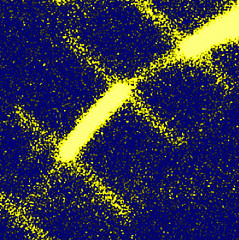

| Visitors Now: | |
| Total Visits: | |
| Total Stories: |

| Story Views | |
| Now: | |
| Last Hour: | |
| Last 24 Hours: | |
| Total: | |
Plasmonics Used to Create an Invisible Photodetector
From
A team of engineers at Stanford and the University of Pennsylvania has for the first time used “plasmonic cloaking” to create a device that can see without being seen – an invisible machine that detects light. It is the first example of what the researchers describe as a new class of devices that controls the flow of light at the nanoscale to produce both optical and electronic functions.
At the heart of the device are silicon nanowires covered by a thin cap of gold. By adjusting the ratio of metal to silicon – a technique the engineers refer to as tuning the geometries – they capitalize on favorable nanoscale physics in which the reflected light from the two materials cancel each other to make the device invisible.
An image showing light scattering from a silicon nanowire running diagonally from bottom left to top right. The brighter areas are bare silicon while the dimmer sections are coated with gold demonstrating how plasmonic cloaking reduces light scattering in the gold-coated sections. Photo: Stanford Nanocharacterization Lab.
Nature Photonics – An invisible metal–semiconductor photodetector
See more and subscribe to NextBigFuture at
Source:



